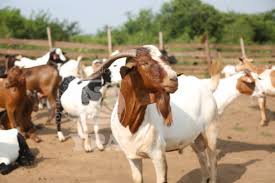Goats and sheep are small ruminant belonging to the tribe, called caprini. This tribe is divided into two parts or genera, Capra and Hemitragus. The Hemitragus, also called Tahrs, are wild goats found in Arabia, the Himalayas and south India. They have short stout horns, no
beards, and long shaggy coats.
They have only 48 chromosomes in their cells and do not cross breed with the Capra, which has 60. The domesticated goat originates from the Capra genus and this includes five groups or species predominating in regions indicated as follows:
• Capra hircus (Bezoar) West Asia
• Capra ibex (Ibex) Central Asia, Near East, Alps
• Capra caucasia (Tur) West Asia
• Capra pyrenaica (Spanish Ibex) Pyrenees
• Capra fakciberi (Markhor) Afghanistan, Pakistan
The Bezoar is thought to the main ancestor of today’s domesticated goat, but the Markhor has had a strong influence in Central Asia where many goats show the long coarse hair and scimitar type horns which are characteristic of both species. The influence of the Ibex is seen in the
prominent ‘Roman nose of breeds such as the Nubian, Jamnapari and Beetal.
Distinguishing the origin of goats is not an easy task. It is practically difficult to tell the difference between a goat and a sheep. The most effective and simple away is to look at the tail. In good health and not under stress, a goat’s tail points upwards, that of a sheep hangs down. Goats can also have beards and the male have tail glands, which sheep do not. Horn shapes and tail or fibre covering may help classify goats, but this can be an unreliable method.
Goat population and distribution

There are some 639 million goats in the world, of which nearly 80 per cenr are found in the tropic and sub- tropics. This compares with world population of 1,067 million for sheep and 1,306 million for cattle. All of these figures are estimates.
Table 9.1 Goat Populations of the Tropics and Sub- tropics
| Millions | % | |
| Africa W. Asia S.E. Asia Indian sub – continent Central America / Caribbean Other Areas | 145 53 14 110 11 18 | 41 15 4 32 3 5 |
The largest populations of goat are found in Africa and on the Indian sub- continent. In the tropics, 20 per cent of the ruminants are goats. It is also known that the population of goats has been growing at a faster rate than other ruminants. Goats are found in all types of environments, from arid to humid zones.
They do very well in the drier tropics, where their ability to withstand dehydration and their browsing habit enable them to survive where cattle or sheep cannot. This means that they can exist in fragile ecosystems such as the Sahel where, consequently, they are often blamed, sometime unfairly, for degrading the natural resource base.
Read Also: General Principles of Goat Production

